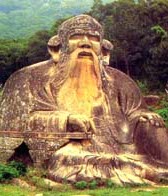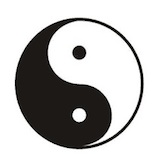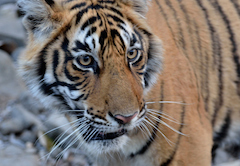What do Daoists believe?
Daoism - the vital statistics
- Daoism (sometimes called Taoism) has its origins 2500 years ago when the Chinese philosopher Lao Zi wrote his classic Dao De Jing, though it draws on folk religion and traditions from long before that time.
- Daoism is the main religious tradition of China and can be found wherever there are Chinese communities across the Far East. The cultural influence of Daoism can also be detected in the art and literature of Japan, Korea and Vietnam.
- Because Daoism was suppressed in 20th century China it is hard to discover how many people follow the tradition. Estimates vary from 20 to 400 million people.
- Traditional Chinese Medicine (TCM), which is the most widely practised medical tradition in the world, was developed from Daoist principles.
What do Daoists believe?
There are three main principles underpinning the philosophy of Daoism:
 |
 |
 |
This statue of Lao Zi is carved from the stone of the mountain, reflecting the harmony of the Dao |
Dao: the way
Though Daoism recognises many gods there is no overarching divinity. Instead, at the heart of the very earliest Chinese vision of the cosmos, there is the Dao, the origin of all. Dao means ‘the way’. The Dao is the origin of everything and the ultimate aim of all Daoists. The Dao is Heaven, Earth and Humanity. The Dao cannot be defined because it exists beyond all forms. In the words of the great Daoist sage, Lao Zi: ‘That which can be named is not the true Dao’. The Dao teaches wu-wei, the way of no-action and no-selfishness. This means to live in a plain and modest way and not to struggle for material gain.
return to the top of the page
The value of life
Daoism regards life as the most valuable thing and pursues immortality. Life can be prolonged through meditation and exercise. People should train their will, discard selfishness, and seek to be a model of virtue. With high moral sense and good exercise, one can maintain energy throughout one’s life. To achieve this, Daoism stresses the need for a peaceful and harmonious environment as a very important external condition.
return to the top of the page
Yin and Yang
 |
 |
 |
The classic design of the Yin Yang represents the balance of opposites |
The process by which the Dao gave rise to reality is defined in the classic text, Dao-De Jing, as follows:
‘The Dao gives birth to the One.
The One gives birth to the Two.
The Two gives birth to the Three.
The Three give birth to the Ten Thousand.’
These words describe how the Dao, the essence of all, gives birth to Nature (the One) which in turn gives birth to Yin and Yang (the Two). Yin and Yang are opposites which must always be in balance:Yin is female, moist, cold, the moon, autumn and winter, shadows and waters. Yang is male, dry, hot, the sun, spring and summer, brightness and earth. The need to balance yin and yang can be applied to everything, including martial arts (Tai Chi), food (macrobiotics) and the arrangement of living conditions (feng shui).
From the perpetual striving of Yin and Yang arises the Three—Heaven, Earth and Humanity. Humanity must try to balance the opposites of Heaven and Earth.
The principle of balancing yin and yang is also the basis of Traditional Chinese Medicine (TCM).
return to the top of the page
Traditional Chinese Medicine (TCM)
Daoism understands illness as a sign that the body is out of balance with nature and for centuries Daoist monks maintained an ancient medical system using herbs and animal parts. This is generally known as Traditional Chinese Medicine (TCM), and it is now thought to be the world’s most widely used medical tradition. To be effective the ingredients used in TCM must be carefully chosen to rebalance yin and yang forces on the understanding that by restoring harmony the ‘illness’ will be removed.
 |
 |
 |
Poachers hunt endangered Sumatran tigers to provide illegal body parts for the TCM market |
In the 20th century, however, when Daoism was being suppressed by the Chinese government, commercial interests promoted TCM in China and the West through the sale of expensive ‘cures’ based on increasingly exotic ingredients. These included rare plants and the body parts of endangered animals such as tigers and rhinos, creating a profitable illegal trade that is pushing many species towards extinction.
From a Daoist point of view, however, the very fact that obtaining such ingredients is unbalancing the natural world means that their use cannot restore the yin/yang balance for the person suffering the illness. Rather than being a cure, Daoists believe, they will actually make things worse.
Once Daoism had been allowed to begin re-establishing itself in monasteries in China the Daoist authorities began identifying appropriate sustainable ingredients for TCM while urging people to reject those illegal (and unhelpful) products.
Read more about TCM
Website for Traffic, the international wildlife trade monitoring network
return to the top of the page
|

